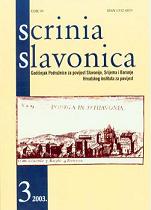Kuga u Požegi i Požeškoj kotlini 1739. godine
Plague in Pozega and Pozega-Basin in 1739
Author(s): Robert SkenderovićSubject(s): History
Published by: Hrvatski institut za povijest
Keywords: Požega; Požeška kotlina (Basin of Požega); plague; epidemic of 1739; demographic losses; recovery
Summary/Abstract: In 1739, Slavonia was struck by the last plague epidemics. The suburbs of Osijek, the town of Požega and a number of villages in Požega Basin were struck most severely. The plague epidemics lasted seven months and more than a half of the residents from this area succumbed to it. The key mechanism against the plague was the establishment of cordons sanitaire. Still, a whole range of cordons that were established on the way to Syrmia, Banat and Bachka could not prevent the plague from spreading through Slavonia. Although the epidemics killed more than a half of its residents, the community of Požega succeeded in compensating for the demographical loss surprisingly quickly. As early as in the first year following the epidemics a large-scale immigration took place and the birth-rate increased dramatically, which made it possible for the town to make up for its lost citizens in an incredibly short period of time.
Journal: Scrinia Slavonica
- Issue Year: 2003
- Issue No: 3
- Page Range: 157-70
- Page Count: 14
- Language: Croatian

